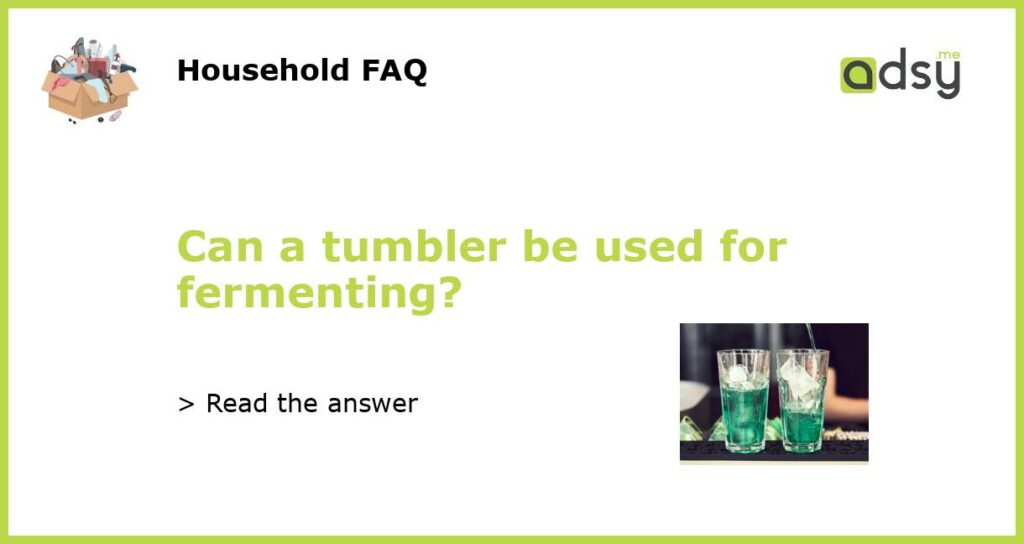Yes, a tumbler can be used for fermenting
When it comes to fermenting food and beverages, there are various containers and equipment that can be used. One option that is gaining popularity is using a tumbler for fermenting. While this may not be the traditional method, it can be an effective and convenient way to ferment your favorite foods and drinks.
The benefits of using a tumbler for fermenting
There are several benefits to using a tumbler for fermenting. First and foremost, it is a space-saving option. Tumblers are typically compact and can easily fit in a small kitchen or pantry. This is especially beneficial for those who have limited space but still want to try their hand at fermenting.
Additionally, tumblers are often made of glass or stainless steel, which are non-reactive materials. This means that they won’t leach any harmful chemicals into your fermented products, ensuring that they are safe to consume. Furthermore, glass tumblers allow you to easily monitor the progress of your fermentation, as they are transparent.
Tumblers also provide an airtight seal, which is crucial for successful fermentation. The lid of the tumbler helps to create an anaerobic environment, allowing the beneficial bacteria to thrive and produce the desired flavors and textures. This makes the fermentation process more consistent and reliable.
Lastly, tumblers are generally easy to clean and maintain. Their simple design and limited number of parts make them a hassle-free option for fermenting. Regular cleaning and sanitizing are important for ensuring the long-term health of your fermentation culture, and using a tumbler simplifies this process.
How to use a tumbler for fermenting
Using a tumbler for fermenting is relatively straightforward. Here are the steps to follow:
- Choose a suitable tumbler: Look for a tumbler that is made of non-reactive material, such as glass or stainless steel. Make sure it has an airtight lid to create the anaerobic environment needed for fermentation.
- Prepare your ingredients: Wash and chop your ingredients as required for your fermenting recipe. This could include vegetables, fruits, grains, or even dairy products.
- Add the ingredients to the tumbler: Place the prepared ingredients into the tumbler, ensuring that there is enough space for expansion during fermentation. Leave some headspace to prevent overflow.
- Add the brine or culture: Depending on your recipe, you may need to add a brine solution or a starter culture. This will help kickstart the fermentation process and introduce the necessary bacteria.
- Seal the tumbler: Close the lid tightly to create an airtight seal. This is important to prevent oxygen from entering the tumbler, as it can hinder the fermentation process.
Once you have followed these steps, you can place the tumbler in a suitable location for fermentation. This could be a cool, dark pantry or a specific fermentation cabinet. Monitor the progress of your fermentation by checking the tumbler regularly.
Popular recipes for fermenting in a tumbler
There are numerous recipes that can be used for fermenting in a tumbler. Here are a few popular options:
- Sauerkraut: Shred some cabbage and mix it with salt. Pack the mixture tightly into the tumbler and let it ferment for a few weeks. The result is a tangy and flavorful sauerkraut that can be enjoyed on its own or added to various dishes.
- Kombucha: Brew a sweet tea and add a SCOBY (symbiotic culture of bacteria and yeast) to the tumbler. Cover it with a cloth and let it ferment for about a week. This will result in a fizzy and probiotic-rich beverage.
- Kimchi: This traditional Korean dish can also be made in a tumbler. Mix sliced cabbage, radishes, garlic, ginger, and chili flakes with salt. Pack it tightly into the tumbler and let it ferment for a week or two. The end result is a spicy and tangy kimchi that pairs well with rice or as a side dish.
These are just a few examples, but the possibilities are endless when it comes to fermenting in a tumbler. Feel free to experiment with different ingredients and flavors to find your favorite fermenting recipes.
In conclusion, a tumbler can be a convenient and effective option for fermenting. It offers several benefits, including space-saving, non-reactive materials, airtight seals, and easy maintenance. By following a few simple steps, you can use a tumbler to ferment a variety of foods and beverages, such as sauerkraut, kombucha, and kimchi. So, don’t hesitate to give it a try and start fermenting your own delicious and healthy creations today!






